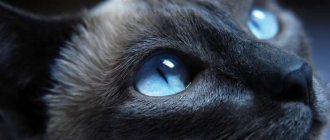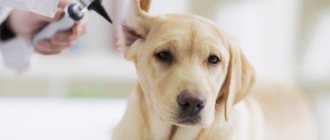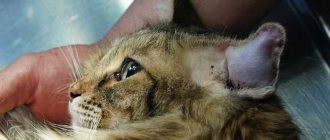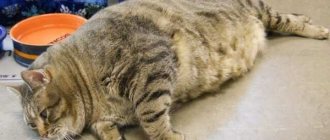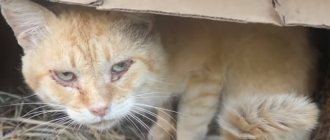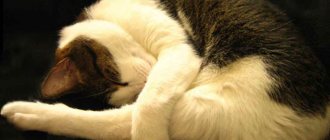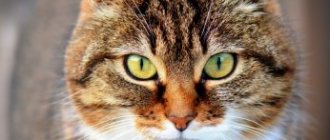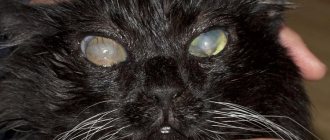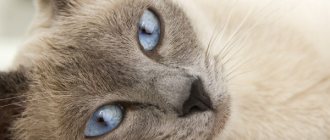Save the article:
Otitis is an inflammation of the ear, which can occur in cats in different forms and have different symptoms. Diagnostics allows you to establish the exact localization of the pathological process and the reasons that caused it. Depending on this, the veterinarian prescribes conservative treatment using appropriate medications. To prevent otitis media in cats, it is necessary to follow preventive measures, which include proper care of your pet.
Types and symptoms of otitis
global $ads_google; //data-ad-slot=”2475549904″ $ads_google = empty($ads_google) ? false : true; ?> if ($ads_google == false) {?>
$ads_google = true; ?> } ?>
The auditory organ consists of outer, middle and inner sections. Anatomical division formed the basis for the classification of otitis media. Types of the disease differ in the location of the source of inflammation. Otitis externa in cats occurs in the mildest form. The pathology does not affect the eardrum and functionally significant structures of the auditory analyzer. The auricle and external auditory canal suffer. If the process is not stopped in time, then it spreads to the deeper parts of the organ.
Symptoms of external otitis include redness of the ear, itching, and swelling of the tissues. During examination, the cat does not allow its ears to be touched, as touching causes pain. Most often, veterinarians diagnose parasitic, fungal or allergic otitis media in such cases.
Otitis media in cats is no less common. Inflammation affects the eardrum, internal auditory canal and tympanic cavity. The pet’s well-being is much worse compared to the first type. The disease sometimes occurs due to the spread of infection from the external part. It could be bacterial otitis media. Treatment in most cases gives a positive outcome, but advanced disease threatens to develop into purulent otitis media.
Bacterial otitis media of the middle ear may be accompanied by purulent-bloody discharge
When the inner ear becomes inflamed, the cochlea (auditory receptors, organ of balance) is affected. Inflammation develops, which can develop into the most severe purulent form. This type of disease is dangerous not only because of deafness, but also because of the possible spread of infection to brain structures. The disease is often accompanied by neurotic symptoms.
According to the speed of development and severity of the course, ear inflammation is divided into acute and chronic. A neglected process or incomplete treatment of an acute form provokes a chronic process. Common symptoms of otitis media in cats are:
- periodic scratching of the ear;
- constant shaking of the head;
- tilting the head to one side;
- unpleasant odor from the ears;
- release of exudate from the ear canal;
- redness of the ears;
- increase in body temperature;
- discharge of pus from the ears;
- neurotic attacks;
- loss of appetite.
Depending on the causes, otitis in a cat can be unilateral or bilateral.
Symptoms of the disease
Otitis media bothers cats in the same way as it does to humans - there is pain, the animal becomes lethargic, restless and even aggressive. A cat may strongly scratch the sore ear with its paws, fold it, often shake its head, tilt it in the direction where the sore ear is.
Hemobartonellosis in cats: symptoms and treatment
Upon visual inspection, any owner may notice reddened and irritated skin, significant internal swelling, and dark brown discharge. At the same time, the cat does not allow you to touch its ear, since any touch causes severe pain.
With the development of purulent otitis, cloudy liquid flows from the ear canal, and squelching often occurs. The released secretion will smell sharp and unpleasant. The disease sometimes causes complications on the facial nerve, which is expressed by a drooping eyelid, ear or lip.
With purulent otitis media, pus with an unpleasant odor is released from the sore ear
If you do not receive timely treatment, the case may progress to a severe stage. The cat's body temperature rapidly rises, which can lead to severe overheating. The animal loses its appetite, becomes indifferent to games and communication with its owner, and becomes irritable.
Without proper treatment, inflammation can penetrate deep into the ear, the course of the disease becomes more complex, and inflammatory processes can affect the meninges. As a result, the vestibular apparatus suffers, which affects the stability of gait. When walking, the cat staggers, stumbles and falls.
Important! Otitis media is a serious disease that can cause irreversible harm to a cat's health. At the slightest symptom, you should contact your veterinarian.
Causes of the disease
Otitis media in cats can be caused by factors related to the functioning of the body, as well as environmental influences. These include:
- fleas and ticks. They are carriers of infection. Inflammation and irritation are also caused by waste products of parasites.
- foreign body. Once in the ear canal, small objects cause local inflammation and swelling.
- bacterial infection. Its development is facilitated by hypothermia, lack of vitamins, viral diseases, and weakened immunity.
- allergens. Individual intolerance to certain foods, medications, and detergents causes a release of histamine in the cat, which can result in allergic otitis media.
- parasitic fungi. They cause inflammation, which most often affects the outer and middle parts of the ear.
- neoplasms. Verrucous nevus and malignant tumors under certain conditions provoke an inflammatory process in the tissues of the auditory analyzer.
- injuries. In the absence of proper treatment, damaged skin turns into a fertile environment for infection. This is how bacterial otitis occurs. Inflammation of the internal part can occur due to injury to the temporal bone.
- autoimmune diseases. As a result of the rejection of one's own tissues, inflammation begins in the ear.
- hormonal disbalance. A change in the concentration of hormones (primarily produced by the adrenal glands, gonads, and thyroid gland) can provoke an inflammatory process.
- growth of fur in the ears. The high density of hairs stimulates the ceruminous glands, which produce earwax. This causes irritation and, as a result, scratching of the integument.
global $ads_google; //data-ad-slot=”2475549904″ $ads_google = empty($ads_google) ? false : true; ?> if ($ads_google == false) {?>
$ads_google = true; ?> } ?>
Symptoms of various types of disease
Feline otitis media has characteristic symptoms. Among them:
- itching and burning in the area of the ears;
- anxiety;
- apathetic and lethargic behavior;
- decreased appetite;
- constant head tilts;
- redness of the ears due to scratching;
- formation of pus;
- increase in body temperature.
The symptoms of the pathology may vary somewhat depending on its type. So, with allergic otitis media, the animal develops severe itching, which affects not only the ears, but also other places. At this time, other signs accompanying the allergic reaction appear.
If the disease is caused by parasites, brown discharge appears in the ears. Infections are accompanied by yellow discharge and fever.
Diagnosis of otitis
When an animal exhibits symptoms of otitis media, it is necessary to contact a veterinary clinic. A doctor examines a diseased organ through an otoscope. This allows you to determine the location of inflammation. The condition of the eardrum is assessed, the presence or absence of foreign inclusions, neoplasms, and the amount of sulfur is determined.
As part of the diagnostic examination, a scraping of the cat's epithelium is taken. It is examined for the presence of subcutaneous mites. The doctor takes a smear of ear discharge for cytological analysis. The laboratory will determine whether bacteria and fungi are the cause of otitis media in your cat. For a general clinical picture, blood and urine are taken from the animal for study. If there is a suspicion of an allergy, then allergy tests are performed: small scratches are made on the skin and allergens are applied to them.
In a particularly difficult situation, when there is a suspicion of a tumor or damage to brain structures, the doctor may prescribe a referral for an X-ray or MRI. The deeper the source of inflammation is located, the more severe the disease. Based on the examination and test results, the veterinarian prescribes treatment for otitis with drops, tablets, and injections.
In some cases, an additional antibiogram is performed - a test for the sensitivity of microbes to certain antibiotics.
Diagnosis of the disease
If contacted in a timely manner, the specialist makes a diagnosis based on the owner’s observations, general examination and otoscopy. With a mild form of the pathology, this is enough to establish the cause and prescribe appropriate medications.
Otoscopy is an examination of the ear canal using a special device. The study allows you to find out whether the eardrum is intact, whether there are foreign bodies in the ear, or determine the presence of a tumor.
Otoscopy is performed after anesthesia.
Otoscopy is an examination of the animal's ear using a special device.
If the middle ear is affected, a cytological smear is necessary to determine the true causes of inflammation. If demodicosis is suspected, trichoscopy can be performed - examination of hairs and particles of the epidermis. In very advanced cases, video-otoscopy, radiography or MRI may be required. The last type of research is more informative.
Veterinarian help
After the veterinarian has determined the causes of the cat's anxiety and made a diagnosis, he prescribes treatment. First of all, with the help of medications, the veterinarian relieves ear pain and itching in the cat. If there is discharge, dirt, or excess wax in the ears, then clean them. It is performed in the following sequence:
- The auricle is turned outward to provide access to the ear canal.
- The fur on the inside of the ear is carefully trimmed.
- A cotton swab is dipped in oil and the plaque is removed within sight.
- The second ear is treated in the same sequence.
For external otitis in a cat, the veterinarian treats the damaged surface and instills liquid medicine, after which he gently massages the auricle to evenly distribute the solution. In case of deep purulent otitis media, the cat's eardrum is pierced to remove pus from the distant parts of the ear. After deep cleaning, the ears are treated with systemic antibiotics. Owners of furry patients are advised to take note of the veterinarian's advice from the following video:
global $ads_google; //data-ad-slot=”2475549904″ $ads_google = empty($ads_google) ? false : true; ?> if ($ads_google == false) {?>
$ads_google = true; ?> } ?>
Symptoms of otitis media
Frequent accompaniments of otitis media are pain, itching, redness of the skin on the inner surface of the ear, and increased discharge from the ears. A cat can often scratch its ear, until bald patches and wounds appear on the auricle, and does not allow the ear to be touched. If a cat shakes its head, this indicates discomfort in the ear canal area.
“Dirty” ears, that is, increased secretion of exudate, is also most often a symptom of otitis media. Normally, in cats, discharge from the ears practically does not accumulate, the auricle is clean. If you often need to clean your cat’s ears, you should consult a dermatologist to determine the cause of such an increased amount of exudate.
Treatment of otitis media in cats
Ear inflammation is a very serious disease, so self-treatment with drops or ointments at home without consulting a veterinarian is not recommended. If you suspect otitis in a cat, you should contact the clinic. After establishing the diagnosis, the doctor will prescribe detailed treatment based on the type of disease.
Purulent otitis media
The prescription of drugs for this type of inflammation depends on the nature of the pathogen. If bacteria are the culprit of the pathology, then otitis media is treated with antibiotics. When using such medications, you should be aware of your cat's sensitivity to them, as some medications cause side effects in animals. For cats, antibacterial agents of the class of cephalosporins, penicillin, and macrolides are used. The dosage is calculated individually for each four-legged patient, based on age, body weight, and severity of the disease.
If the eardrum is damaged, do not use ototoxic antibacterial drugs (Norfloxacin, Rifamycin, Ciprofloxacin), as they negatively affect hearing.
Fungal otitis media
For otomycosis, the cat is treated with fungicidal drops or ointments based on nystatin. Treatment of parasitic otitis necessarily includes hygiene procedures aimed at cleansing the surface of the outer ear. The ointments are applied to the clean surface for sanitation. In addition to local medications, the cat is prescribed general antifungal medications.
Treatment of otitis in cats should be carried out in compliance with general rules of care. The animal should be protected from drafts and hypothermia. It is necessary to minimize stressful situations. The pet should be at rest and warm.
Allergic otitis media
If the inflammatory process is associated only with increased histamine synthesis in the cat’s body, then antihistamines are used to relieve unpleasant symptoms. The animal is treated using Tavegil, Fexofenadine, Suprastin, Loratadine, Cetirizine. In case of severe inflammation, the use of anti-inflammatory corticosteroids (Prednisone, Prednisolone) is justified. In combination with them or separately, the doctor may prescribe Dexamethasone. Ear mites often cause an allergic reaction. In this case, antiparasitic treatment is necessary in parallel.
Parasitic otitis media
This common form of otitis in cats requires the use of special drugs, the action of which is aimed at destroying ear mites. Treatment is carried out using anti-inflammatory and acaricidal drugs. They can be in the form of ointments, aerosols, drops. Dekta, Amitrazine, Otopheronol Gold are suitable for this purpose. Therapy also includes regular cleansing of secretions from the auditory organ. Owners need to treat their pets for fleas and ticks on a schedule.
global $ads_google; //data-ad-slot=”2475549904″ $ads_google = empty($ads_google) ? false : true; ?> if ($ads_google == false) {?>
$ads_google = true; ?> } ?>
How and with what to treat?
Based on the symptoms of otitis media in cats and research results, the doctor prescribes treatment.
- For local treatment of otitis media, acaricidal ear drops for cats (Acaromectin, Bars, Anandin+), anti-inflammatory drugs (Aurican, Otonazole), healing ointments (Levomikol, Iruksovitin) are used.
- Allergic otitis media is treated with antihistamines (Suprastin, Tavegil), and corticosteroids are prescribed if necessary. It is necessary to eliminate the cause of the allergy and transfer the sick animal to a therapeutic diet.
- Fungal otitis media in cats is treated with antimycotic ointments (1% Econazole, Panolog, Clotrimazole, Salicylic, Nystatin) and drops (Tolnaftate).
- To treat purulent inflammation, ear rinsing is required in a veterinary clinic. Often this pathology requires surgical intervention. Next, to treat the animal, drops for otitis media for cats (Otospectrin, Amitrazin+, Otibiovet) are used. Antibacterial treatment is carried out in the form of injections with drugs from the penicillin or cephalosporin group.
- The ears are cleaned with antiseptic lotions (Rosinka, Otifri) or disinfecting solutions (Chlorhexidine, Miramistin).
- Lidocaine and Loxicom are used for pain relief
Lidocaine
Medicines for otitis media
Treatment of otitis is carried out using systemic and local drugs. The prescription list includes medications recognized in veterinary medicine. Basic therapy can be supplemented with traditional medicine. To achieve a positive result, it is important to follow the treatment regimen and duration of the course prescribed by the veterinarian.
Medicines of official medicine
To sanitize the auricle and external auditory canal, use sterile gauze wipes soaked in an antiseptic solution. Boric acid (3%), chlorhexidine, hydrogen peroxide (3%), furatsilin, miramistin are suitable for this purpose. If the eardrum is not damaged, then drops for otitis media can be used for treatment:
- Sofradex;
- Dexamethasone;
- Aurikan;
- Uricin;
- Surolan;
- Anandin;
- Otibiovet;
- Tsiprovet;
- Tsipam;
- Otovedin.
Otibiovet
The medicine comes in the form of clear drops. The dropper bottle can have different volumes - 20, 30 or 50 ml. The drug is used for otitis of the external and middle ear. Active substances (gentamicin sulfate, triamcinolone acetonide, salicylic acid, carbetopendicinium bromide) act against bacteria and fungi. Drops reduce itching, discharge, and reduce the manifestations of dermatitis.
Surolan
An oily suspension containing miconazole nitrate, polymyxin B sulfate, prednisolone acetate. This is a combined drug that has anti-inflammatory, antibacterial, fungicidal, and antiallergic effects. The volume of the bottles is 15 or 30 ml.
If otitis in cats is caused by bacteria or they are a secondary cause of inflammation, systemic antibacterial drugs are prescribed. The use of these medications is also justified for fungal otitis in order to prevent infection by bacterial microflora. The list includes:
- Amoxiclav;
- Ampicillin;
- Amoxicillin;
- Cefazolin;
- Ceftriaxone;
- Cefixime;
- Erythromycin;
- Clarithromycin;
- Azithromycin;
- Spiramycin.
Ampicillin
global $ads_google; //data-ad-slot=”2475549904″ $ads_google = empty($ads_google) ? false : true; ?> if ($ads_google == false) {?>
$ads_google = true; ?> } ?>
Semi-synthetic drug of the penicillin series. Available in the form of tablets and powder for suspension. The medicine has a broad antimicrobial effect. The tablets are given to the cat on an empty stomach or 2 hours after eating.
Cefixime
Semi-synthetic antibiotic from the group of cephalosporins in tablets or powder. Active against many pathogenic bacteria. Used to treat otitis media in the acute stage. Not suitable for small kittens and sick elderly pets.
To treat integuments affected by parasitic fungi, fungicidal ointments are used: Panolog, Oridermil, Clotirmazol, Nystatin. In some cases, MycoStop ProVET antifungal drops are indicated. Complex therapy includes vitamin-mineral complexes and immunomodulators (Imunofan, Ribotan). They help the cat's body resist infection.
Folk remedies
Additional support for otitis media in cats is also provided by traditional medicine recipes. They are easy to prepare and use at home. The most harmless solution is considered to be a solution made from strong green tea. The filtered tea leaves are used to wipe the cat's ears. This product has a disinfectant and acaricidal effect. An infusion of herbs with antibacterial and anti-inflammatory effects has a similar effect. Chamomile, string, lavender, birch leaves, and St. John's wort are suitable for processing.
Bacterial otitis
Bacterial or microbial otitis is almost always secondary, due to allergies or injuries to the ear cavity. One of the fairly common causes of ear injury in cats is improper cleaning using cotton swabs. Cats have a completely different structure of the auricle; when using cotton swabs, the ear canal is not cleaned due to its anatomical features. The ear canal is curved, so when you try to clean the ear with a cotton swab, all the secretions are compacted, their outflow is disrupted, and this provokes the so-called congestive otitis media. Active cleaning with a cotton swab often causes injuries; cotton fibers remain in the ear, which can also cause inflammation.
Ceruminous otitis media develops against the background of irritation of the skin of the external auditory canal. It is characterized by increased release of sulfur. Frequent ear cleaning, especially using cotton swabs, also contributes to its development. The more the wall of the external auditory canal is irritated, the more the glands work.
Prevention of ear otitis
To prevent the development of otitis media in a cat, you must follow simple rules of prevention. Periodically, your pet's ears are checked and excess wax and dirt are removed. For cleaning, you can use cotton pads or swabs, gauze wipes. In this case, only visible areas are treated with a cotton swab, without penetrating deep into the ear cavities.
The pet must be protected from drafts and hypothermia. This is especially important after swimming. When washing, water should not get into the animal's ears. After the water procedure, blot the inside of the ears with a cotton pad. Excess hair in the ears is trimmed, this improves ventilation of the ear cavity.
Kotofeya needs to be treated for fleas and ticks in a timely manner. Drops applied to the withers contain substances that kill subcutaneous mites, so they help prevent otodectosis. It is advisable to protect your pet from contact with homeless relatives, who are often carriers of infectious diseases.
At the first symptoms of otitis media, you should immediately seek help from a veterinarian, since advanced inflammation can develop into purulent otitis media.
It is more difficult to treat this form of the disease and, most importantly, it threatens serious complications. The cat may lose hearing, and in more severe cases, the infection can spread to the meninges and cause meningitis. global $ads_google; //data-ad-slot=”2475549904″ $ads_google = empty($ads_google) ? false : true; ?> if ($ads_google == false) {?> $ads_google = true; ?> } ?>
Symptoms and signs of ear inflammation in cats
Thus, the symptoms and signs of ear inflammation in a cat largely depend on the location of the inflammatory process. The deeper it is, the more severe the disease.
But still, “pure” types of otitis are rare, and therefore the clinical picture is usually mixed:
- A sick cat, almost from the first days, constantly shakes its head and scratches its ears all the time. If inflammatory exudate has already accumulated in the ear cavities, then at these moments it abundantly irrigates the room. For the same reason, a sick pet (especially its ears) can smell very unpleasant.
- With otitis media or internal otitis, the cat often sits with its head tilted to one side. This is how the animal tries to ease the pain. The pet is extremely apathetic and completely refuses food. A sick cat drinks rarely and reluctantly. It can be seen how every tilt of the head causes severe pain to the animal.
- In some cases, cats literally “roll” on the floor, shaking their ears on the floor. Traces of exudate are often visible on floor coverings.
- As has been repeatedly stated above, with serious types of inflammation the cat’s condition seriously deteriorates and she refuses to feed.
- If you look closely at the skin and fur near the ears, you can often see dried crusts and fresh exudate.
Causes of ear infections
The structure of the hearing organ in cats is practically no different from the structure of the human ear.
In the vast majority of clinical cases, otitis externa is diagnosed,
affecting only those parts of the hearing organ that are visible to the naked eye.
Otitis media
represents a more dangerous pathology, but with proper adequate treatment, the chances of a complete recovery and restoration of the functionality of the cat’s ear increase significantly.
The most dangerous thing is the deep inner oti
t in cats, affecting parts of the inner ear. The inflammatory process developing directly in the inner ear leads to deafness of the animal, and there is also a high probability of purulent contents passing from the ear into the brain structures.
The factors that provoke the development of inflammation are very diverse. Parasitic otitis in cats occurs as a result of damage to the ear shell by ear mites or as a reaction to flea bites. The damaged dermis, due to a decrease in the overall resistance of the body, becomes an excellent environment for the proliferation of pathogenic bacterial microflora. The excrement of fleas and ticks, as well as the saliva of parasites, are excellent for feeding bacteria.
No less common is allergic otitis media in cats, which occurs as a result of a specific reaction of the body to various foreign proteins that enter the pet’s body. Allergies can be caused by food allergens, parasite bites, and helminthic infestations.
Against the background of a general decrease in immunity, bacterial microflora and fungal microorganisms are activated. The addition of bacteria and fungi to an allergic reaction is often diagnosed in tandem in the clinical practice of a veterinarian.
Other causes of otitis in cats are:
- Hypothermia
. Against the background of hypothermia, the overall resistance decreases. Otitis media can develop in a pet after being outside for a long time in cold, damp weather, or as a result of a draft from a window. Otitis media can be a complication that develops against the background of an acute respiratory infection or other diseases affecting the respiratory tract. - injuries .
The ears of cats are often exposed to negative environmental factors - fights with other cats, blows and bruises when falling from heights, lacerations after prolonged climbing of trees. The disease in such cases develops quite slowly, resulting in slight inflammation of the outer area of the ear concha. Advanced cases lead to otitis media of the external and middle ear. - Sulfur plug
. Excessive formation of a specific substance in the ear canal if not removed in a timely manner causes blockage of the auditory canal. As a result, an inflammatory type reaction develops, turning into otitis media. Treatment of otitis in the early stages without the addition of pathogenic pyogenic microflora is quite fast and not problematic. - Infectious
dermatitis . Various fungal and bacterial skin lesions negatively affect not only the condition of the animal’s skin, but can also lead to serious complications, one of which is bacterial otitis media in cats. When a cat itches, it can easily spread the infection over the entire surface of the body, including the ears. Mycoses of the skin can be independent, or they can develop against the background of other diseases, as well as bacterial lesions. In advanced cases of otitis externa, purulent otitis often occurs in cats, which poses a great danger to the animal. As a result of the passage of purulent exudate along the ascending path, it is possible to perforate the eardrum and develop inflammation in the deep layers of the ear.
Signs
The most common signs of vestibular system disease are:
- ataxia (lack of coordination and balance);
- head tilt;
- movement in a circle;
- falling to one side of the body;
- nausea (motion sickness);
- strabismus (deviation of the eyeballs) and nystagmus (anterior and posterior, superior and inferior, or rotational movement of the eyes).
The cat will fall, spin, or tilt its head towards the side of the body where the main disturbance is located.
Diseases of the vestibular apparatus are divided into peripheral (if the disease lies in the inner ear) and central (if the brain stem is affected). In addition, signs of the disease may be unilateral or bilateral. Cats with bilateral peripheral problems exhibit mild feelings of disorientation; but the muscles of their limbs function normally.
Deficits in postural responses such as placement and proprioception of the limbs may be present, along with mental decline (depression or decreased consciousness). Rarely, a form of central vestibular disease affects the side of the body opposite the affected side. The development of neurological deficits in a cat's head may involve loss of sensation or movement of the face.
Treatment at home
Please note that treatment at home can only be carried out after consultation with a veterinarian, an accurate diagnosis and the veterinarian prescribing all necessary medications. We do not recommend engaging in “amateur activities”, as this is a guarantee of serious consequences! An approximate treatment regimen is as follows:
- Excess hair around the ears and ear canals is carefully trimmed, as this greatly facilitates the treatment process.
- Dried crusts and fresh exudate are removed from these areas daily using cotton swabs soaked in warm, sterile saline or chlorhexidine. We strongly advise against drilling into the ear canal with cotton swabs, as this will only lead to further spread of the inflammatory process!
- Medicinal drops are instilled into the ear canals daily (the frequency must be determined by a veterinarian) or medicinal ointments are placed there.
- Depending on the root cause of inflammation, they resort to injection or oral administration of antibiotics or other antimicrobial drugs (or antifungals).
- Anti-inflammatory corticosteroids are used to stop the inflammatory process.
Rules for cleaning the ears of cats and cats
In the process of cleaning the ears of cats and cats, the following sequence must be observed:
- Place the cat sideways on your lap, pressing its head and whole body towards you. If the cat breaks out, grab it by the withers, or use a towel as follows: take a regular towel and wrap the cat in it, as if you were swaddling a child, then, clasping the head with one hand so that it does not turn it or open its mouth, with the other hand turn out the auricle out.
- Open your cat's ear and inspect it for dirt, discharge, or redness.
- If there is strong discharge, take a cotton swab soaked in chlorhexdine, squeeze it out and carefully wipe the inner surface of the ear, without going too deep.
- If you need to put drops in your cat's ear, carefully lower the nipple of the bottle with drops a couple of millimeters into the ear canal and squeeze out the number of drops required according to the instructions.
- Do not let the cat go immediately after instilling the drops, it will start shaking its head and all the medicine will come out. Gently massage the base of the ear so that the drops reach their destination.
- If you use cotton swabs to clean your cat's ears, don't try to push them deep inside as you may either push dirt deeper or damage the ear canal.
- At the end of the ear cleaning or ear drop procedure, pet and praise the cat. Give her a treat.
Cats need to clean their healthy ears as needed. And in case of illness (otitis media, inflammation, ear mites), clean your ears at least 2 times a day.
If your cat's ears are quite clean, you can, say, after bathing, simply blot off the remaining moisture with a cotton swab. Because frequent ear cleaning leads to the removal of the protective microflora of the ears. The timing of the ear cleaning procedure can be different, one might say, individual for each breed, for example, for the Persian breed the frequency may be about a month.
Caring for your cat during treatment
You should know that it is impossible to get otitis from a cat, but you should not forget about the rules of personal hygiene.
Most likely, a sick cat will be prescribed a so-called Elizabethan collar. Do not neglect this accessory, since a pet without it can harm itself, comb or scratch the affected area of the ears.
In addition to the remedies prescribed by the veterinarian, it is necessary to clean the ears of pus and treat them with an antiseptic. And after completing the course, monitor the condition of the ears for a few more weeks to avoid relapse.
In the future, MURlyka’s ears should be cleaned 1-2 times a month.
By the way, do you know what to feed your hamster? See what fruits and vegetables you can feed + review of ready-made food!
Otitis externa
According to the prevailing views in veterinary medicine, there are four main aspects that are of key importance from the point of view of the formation of otitis media in dogs: primary causes, secondary causes, predisposing factors, supporting factors. Previously, there was an opinion among scientists that infections in the ear canals are the primary cause of otitis media. Subsequently, it was found that infections are secondary, and their development requires previous underlying causes.
Primary causes include allergies (adverse reaction to food, atopic dermatitis, often associated only with otitis media, contact allergies, flea allergic dermatitis); autoimmune diseases (diseases from the group of bullous dermatoses, systemic lupus erythematosus, pemphigus foliaceus and others); endocrine diseases (hyperadrenocorticism, hypothyroidism); diseases that negatively affect the physiology of the keratinization process (primary idiopathic seborrhea, sebadenitis, vitamin A-dependent dermatosis, zinc-dependent dermatosis and others); foreign bodies (hair, plant particles, sand, soil and others); disorders of the accessory glands of the skin lining the auditory canals (for example, hypo- or hyperplasia of the sebaceous glands); immune-mediated diseases (local or systemic drug reactions, erythema multiforme, vasculitides and vasculopathies) and various other diseases (chondritis of the auricular cartilage, eosinophilic granuloma complex, idiopathic inflammatory/hyperplastic otitis of cocker spaniels, juvenile cellulitis, proliferative necrotizing otitis of cats; parasitic diseases ( otodecosis, demodicosis)).
Secondary causes are some factors that worsen the condition of an already sick animal. These factors are microorganisms: bacteria - cocci (Staphylococcus, Streptococcus, Enterococcus) and rods (Pseudomonas, Proteus, Escherichia coli, Klebsiella, Corynebacterium); mushrooms (Aspergillus spp., Candida spp., Malassezia spp. (in the vast majority of cases)); all kinds of chemical irritants (for example, alcohol, propylene glycol); physical factors (eg, excess moisture in the ear canal, additional trauma from ear sticks).
Predisposing factors arise even before the development of otitis, for example, the very structure of the ear can further contribute to the development of otitis (loop ears, stenotic ear canal (in Shar Pei), excessive hair growth in the hair canals, and others).
In addition, there is a group of supporting factors that arise, as a rule, due to the chronic course of otitis media, which prevents a good cure even in cases where therapy is aimed at taking control of the primary and secondary causes. The consequence of this is frequent relapses of clinically pronounced otitis or their subclinical course. Factors supporting otitis include disturbances in the migration of epithelial cells that form the lining of the auditory canal; various changes observed in the ear canal (for example, proliferative changes and stenosis of the auditory canal. Photo 3); violation of the integrity of the eardrum (for example, diverticulum, scar, rupture); disorders of the accessory glands (inflammation, hyperplasia); mineralization of tissues of the auditory canal; concomitant inflammatory processes of the middle ear. Thus, it is important for the clinician to consider all the above reasons and factors. This approach is considered optimal for solving problems associated with the presence of otitis media in dogs and cats3-5.
Primary causes
Allergic diseases (atopic dermatitis, food allergies, contact hypersensitivity - a reaction to the introduction of medications such as propylene glycol, neomycin and others into the auditory canal) are the cause of otitis, they account for 43% of cases of the total number of all cases of otitis. It is believed that chronic otitis media is most often associated with allergic diseases; for example, 75% of cases of chronic otitis media were associated with atopic dermatitis. At the same time, the authors note that an allergy to air allergens in 5% of dogs can be represented only by otitis media without accompanying dermatitis. Other data indicate that 83% of dogs with atopic dermatitis have a clinical history of otitis media. Thus, otitis media very often accompanies allergies 6-9. Chronic ceruminous otitis is caused by diseases leading to impaired keratinization - hypothyroidism (most often) and other endocrinopathies; as well as diseases associated with the development of primary seborrhea (for example, ichthyosis of golden retrievers) or idiopathic seborrhea. Diseases of the accessory glands of the skin. There may be a breed predisposition in some dog breeds (for example, cocker spaniels), some of which have more sebaceous glands than other individuals of the same breed, which may be a likely condition for the development of otitis media 10. In addition, interbreed differences in the number of sebaceous glands and hair follicles between Labradors, English Springer Spaniels (they have more skin appendages), and Greyhounds and mixed breeds (they have fewer sebaceous glands and hair follicles in the ear canals). Other underlying causes include a number of diseases, for example, proliferative eosinophilic otitis of the external ear in dogs 11. This idiopathic disease involves damage to both auditory canals and is accompanied by the development of multiple polypoid formations on the surface of the ear canals. Histologically, papillomatous proliferative eosinophilic dermatitis or eosinophilic granulomas are detected. Feline proliferative and necrotizing otitis externa 12 is also a syndrome of unknown etiology. In the auditory canals, hyperkeratotic crusts and erythematous plaques are formed and, as a rule, bilateral symmetry is observed. In some cases, not only the ears are involved, but skin lesions on the face, around the eyes and around the mouth may also develop. Sometimes a generalized process develops. Idiopathic inflammatory and hyperplastic otitis of the external ear of cocker spaniels 13. There is no clear idea of what is the specific reason for the formation of otitis in dogs of this breed at an early age (from about a year after birth), which subsequently rapidly progresses and leads to rapid proliferation of tissues of the auditory canals and, as a consequence, their mineralization. According to various versions, this problem can be caused by food hypersensitivity, primary idiopathic seborrhea, or, possibly, diseases of the accessory glands of the skin lining the ear canal.
Secondary causes arise when there are underlying causes of otitis or factors predisposing to its development, or when we are talking about a chronic process, and changes in the auditory course are such that optimal conditions are created for the development of secondary causes of ear inflammation, represented by various secondary infections. Bacteria isolated from the inflamed ear and representing a secondary infection are usually represented by Staphylococcus pseudintermedius, Pseudomonas, Proteus, E. coli and Klebsiella 14-20. In chronic otitis media in the inflamed ear, Pseudomonas spp are most often identified. According to the authors, the likely reason for the growth of this particular microorganism is the development of a moist environment in the ear, the pH value of which tends to shift towards the alkaline side, which, in turn, is caused by edema, tissue hyperplasia and the presence of a significant amount of secretion from the ceruminal glands in the auditory canal. The yeast Malassezia pachydermatis is the most common yeast secondary infection in otitis media. It is a budding yeast that looks like a peanut. With otitis, almost 76% of patients have this problem, often combined with the presence of staphylococcal infection 21-23. It is believed that the causes leading to the development of secondary yeast infections of the ears are allergic diseases; superinfections that occur after antibiotic therapy 24-25; increased humidity in the ears (formed, for example, after swimming or when using various products introduced into the ears) and some others.
Diagnostics
Diagnosis of vestibular diseases requires a thorough history and careful examination. To choose the direction of diagnosis, it is important to first determine whether it is a central or peripheral disorder. It is necessary to check both auditory tracts and eardrums along with an assessment of the neurological condition of the animal.
Basic laboratory tests include a complete blood count, blood chemistry panel, and urinalysis. Basic testing will also include tests for feline leukemia virus, feline immunodeficiency virus, and titers for feline coronavirus, toxoplasmosis, and cryptococcus. Evaluation of elevated immunoglobulin G titers and the presence of immunoglobulin M titers may be a sign of active toxoplasmosis infection.
X-rays of the head can help detect ear diseases by identifying changes in the tympanic bulla. However, x-ray is not a specific diagnostic method and does not show the soft tissues involved in the pathological process. New imaging techniques, such as computed tomography (CT) or tomography (MRI), are much better at localizing lesions in the ear or brain. MRI is particularly useful in detecting soft tissue lesions.
Because MRI is expensive, it is more often used to distinguish between central (brain) and peripheral (ear) disease after basic preliminary tests have been performed.
If encephalitis is suspected, cerebrospinal fluid (CSF) is taken for analysis. One of the most common causes of encephalitis is feline infectious peritonitis (FIP). FIP occurs primarily in cats under two years of age and is a progressive disease. The brain stem and spinal cord are the first to be affected. CSF analysis will demonstrate elevated levels of protein, predominantly globulins, and a moderate number of white blood cells, predominantly neutrophils or lymphocytes. Antibody titers or PCR virus presence may be inconclusive.
Otitis caused by the presence of a neoplasm or foreign body
Otitis develops when foreign bodies enter the ear. Often the cause is the same cotton swabs, which break off or cotton flakes separate and get into the ear canal. Also, the cause may be grass seeds - this is typical for cats walking in the country.
It is not uncommon for cats to develop neoplasms of the ceruminous glands (glands that secrete sulfur). Such tumors are called cerumin. If the tumor opens and becomes infected, then purulent, and sometimes purulent discharge mixed with blood, can be observed from the ears. In such cases, it is necessary to perform otoscopy to visualize the tumor.
Types of inflammatory process in the ear
Otitis externa is the mildest course of the disease. In this situation, only a small part of the external auditory canal is affected. But if timely treatment is not started, the inflammation can move deeper into the ear canal, resulting in a purulent stage.
Purulent otitis media
The purulent form occurs not only due to complications of external otitis, but also through parasitic infection, the penetration of yeast infections and microbes. This form of the disease is characterized by discharge from the ear with an unpleasant odor, increased body temperature, and swelling of the ear. Often purulent otitis media can occur as a result of damage to the ears by mites. This phenomenon is called otodectosis in medicine.
Bacterial otitis
It is common and affects both one or both ears. In such a situation, the cat experiences severe itching, purulent fluid is released, the auricle becomes inflamed and red, and a persistent unpleasant odor is detected. With significant damage to streptococcus, staphylococcus, Pseudomonas and Escherichia coli bacteria, a chronic stage develops.
Fungal otitis media
Veterinarians call this form otomycosis. The disease can develop either independently or in the form of a secondary disease. Inflamed skin becomes defenseless against damage by microorganisms, as a result of which the fungus causes infection and provokes the development of otitis media.
The ear of a sick cat becomes swollen and red.
First, the cat experiences severe itching, then a lot of wax accumulates in the ear, and the ear canal becomes red. This is how the inflammatory process begins, which is then accompanied by swelling; pus with an unpleasant odor appears in the cat’s ear.
Treatment
Treatment will depend on the stage of ear inflammation and the cause that caused it. Only a veterinarian can determine it after laboratory tests. It is possible to identify the pathogen by taking a smear.
If your cat has otitis externa, topical treatments will suffice. Complex drugs such as Otibiovet, Aurikan, Otonazole are effective.
Before starting drug treatment, the cat's ear is cleaned of purulent crusts.
Preference should be given to cotton swabs, since cotton swabs are easier to damage the hearing organ. To soften deposits, use Otifri, Otoklin, Epi-Otik drops. They are instilled into the ear, allowed to act for several minutes and the deposits are removed with cotton wool.
If the inflammation is parasitic in nature, the veterinarian will prescribe the drugs Bars, Amitrazine, Dekta, Rolfclub. Fungal otitis is treated with Clotrimazole, Terbinafine, Nitrofungin.
For bacterial types of inflammation, Otibiovin, Anandin, Fugentin, Sofradex are prescribed. To quickly restore a weakened body, immunostimulants and vitamin complexes are prescribed.
The duration of treatment for ear infections varies from person to person and can be up to 3 weeks . In the case of bacterial otitis, antibiotics are used for no more than 1 week, and if there is no result, the drug is changed.

